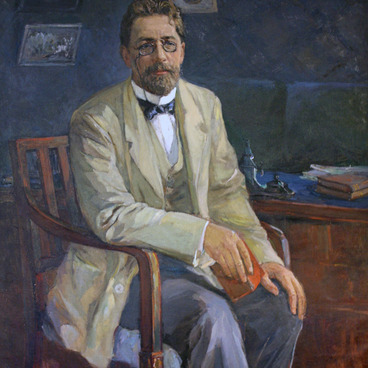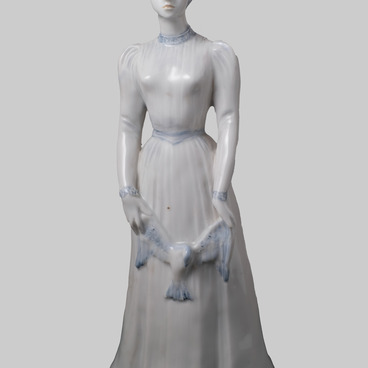The writer’s sister, Maria Pavlovna Chekhova, lived in Chekhov’s Yalta house until 1957. She was a teacher of geography and history, was fond of painting. Her teachers were Isaac Levitan, Valentin Serov, Konstantin Korovin. In our museum there are several works by Maria Pavlovna: three studies in the dining room, two in the guest room, as well as a portrait of a girl - ‘cousin Lyolia’ in the room for relatives. Maria Pavlovna lived in Chekhov’s Yalta house for almost 60 years, she died in 1957. She founded the first Chekhov’s museum in the world - in Yalta and was its director and careful guardian until the end of her life. She also helped open Chekhov’s museums in Moscow, Melikhovo, Taganrog, Sakhalin.
The bust of Maria Pavlovna Chekhova was created Alexander Fyodorovich Molokanov in April 2007 from her photograph taken in 1937. The bust is placed on a rectangular base, on the front edge of which the author’s inscription in two lines is cut: ‘Maria Pavlovna Chekhova’, on the right-side edge in the same way - ‘1937’.
Since 1944, Alexander Fyodorovich Molokanov (1937-2010), together with his grandmother, who replaced his mother, lived in the Crimea, in Yalta. He lived in a small house in Aoutka, not far from Chekhov’s White Dacha. After graduating from the Art School in Rostov, he returned to Yalta and got a job at the Vasilyev’s Art School. By his own hands in the courtyard of his house he set up an Art Gallery. Among his sculptural works, there are several more compositions associated with Chekhov, like ‘A. Chekhov and I. Bunin “,"A. Chekhov with his wife Knipper-Chekhova’. Usually, the author used copper and marble for his sculptural works. The bust of Maria Pavlovna is made of plaster.
Chekhov bequeathed his house in Yalta to his sister. There are interesting recollections of the writer’s niece, Evgenia Mikhailovna Chekhova: ‘At the beginning of the 20th century, plays by the Norwegian writer Heinrich Ibsen, including the “Master Builder”, had great success and were staged in many theaters. Maria Pavlovna received this humorous nickname from the household - the Master Builder, since she took an active part in the construction and improvement of the house. She was naturally gifted with love of creation.
Addressing his will to “dear Masha”, Chekhov wrote on August 3, 1901 in Yalta that he bequeathed to her, in addition to the house, “income from dramatic works”, says that she can sell the real estate, if she wants. Reminds that he promised the peasants of the village of Melikhovo 100 rubles “to pay for the highway”, and to Gavriil Alekseevich Kharchenko “to pay for his eldest daughter to the gymnasium until she is released from the tuition fees.” The writer also urges his sister to help the poor, take care of her mother and live peacefully.
The bust of Maria Pavlovna Chekhova was created Alexander Fyodorovich Molokanov in April 2007 from her photograph taken in 1937. The bust is placed on a rectangular base, on the front edge of which the author’s inscription in two lines is cut: ‘Maria Pavlovna Chekhova’, on the right-side edge in the same way - ‘1937’.
Since 1944, Alexander Fyodorovich Molokanov (1937-2010), together with his grandmother, who replaced his mother, lived in the Crimea, in Yalta. He lived in a small house in Aoutka, not far from Chekhov’s White Dacha. After graduating from the Art School in Rostov, he returned to Yalta and got a job at the Vasilyev’s Art School. By his own hands in the courtyard of his house he set up an Art Gallery. Among his sculptural works, there are several more compositions associated with Chekhov, like ‘A. Chekhov and I. Bunin “,"A. Chekhov with his wife Knipper-Chekhova’. Usually, the author used copper and marble for his sculptural works. The bust of Maria Pavlovna is made of plaster.
Chekhov bequeathed his house in Yalta to his sister. There are interesting recollections of the writer’s niece, Evgenia Mikhailovna Chekhova: ‘At the beginning of the 20th century, plays by the Norwegian writer Heinrich Ibsen, including the “Master Builder”, had great success and were staged in many theaters. Maria Pavlovna received this humorous nickname from the household - the Master Builder, since she took an active part in the construction and improvement of the house. She was naturally gifted with love of creation.
Addressing his will to “dear Masha”, Chekhov wrote on August 3, 1901 in Yalta that he bequeathed to her, in addition to the house, “income from dramatic works”, says that she can sell the real estate, if she wants. Reminds that he promised the peasants of the village of Melikhovo 100 rubles “to pay for the highway”, and to Gavriil Alekseevich Kharchenko “to pay for his eldest daughter to the gymnasium until she is released from the tuition fees.” The writer also urges his sister to help the poor, take care of her mother and live peacefully.



